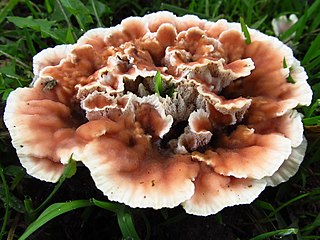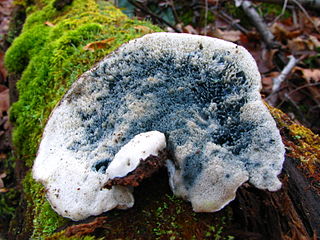
The Ustilaginomycotina is a subdivision within the division Basidiomycota of the kingdom Fungi. It consists of the classes Ustilaginomycetes and Exobasidiomycetes, and in 2014 the subdivision was reclassified and the two additional classes Malasseziomycetes and Moniliellomycetes added. The name was first published by Doweld in 2001; Bauer and colleagues later published it in 2006 as an isonym. Ustilagomycotina and Agaricomycotina are considered to be sister groups, and they are in turn sister groups to the subdivision Pucciniomycotina.

Ustilaginoidea virens, perfect sexual stage Villosiclava virens, is a plant pathogen which causes the disease False Smut of rice which reduces both grain yield and grain quality. The disease occurs in more than 40 countries, especially in the rice producing countries of Asia. but also in the U.S. As the common name suggests, it is not a true smut (fungus), but an ascomycete. False smut does not replace all or part of the kernel with a mass of black spores, rather sori form erupting through the palea and lemma forming a ball of mycelia, the outermost layers are spore-producing. Infected rice kernels are always destroyed by the disease.

Julius Oscar Brefeld, usually just Oscar Brefeld, was a German botanist and mycologist.

The Arthoniaceae are a family of lichenized, lichenicolous and saprobic fungi in the order Arthoniales. The Arthoniaceae is the largest family of Arthoniales, with around 800 species. Most species in Arthoniaceae belong in Arthonia which is the largest genus with 500 species. The second and third largest genus is Arthothelium with 80 species, and Cryptothecia with 60 species.

Lecidella is a genus of crustose lichens in the family Lecanoraceae.

Abortiporus is a genus of fungi in the family Meruliaceae. The widely distributed genus contains three species. Species in the genus grow on the wood of hardwoods and conifers, either alone or around the stumps and living trees. It causes a white rot in dead wood and a white trunk rot in living wood. The genus was circumscribed in 1904 by William Alphonso Murrill. The generic name is derived from the Latin abortus and the Ancient Greek πόρος (pore).

Oligoporus is a genus of fungi in the family Polyporaceae. The genus was circumscribed by German mycologist Julius Oscar Brefeld in 1888 with Oligoporus farinosus as the type. This species is currently known as Postia rennyi. The genus name combines the Ancient Greek words ὀλίγος ("few") and πόρος ("pore").
Dictyonema is a genus of mainly tropical basidiolichens in the family Hygrophoraceae.
Paul Sydow was a German mycologist and lichenologist, father of Hans Sydow (1879–1946).

Craterocolla is a genus of fungi in the family Sebacinaceae. The genus was circumscribed by Julius Oscar Brefeld in 1888 with C. cerasi as the type species.

FriedrichWilhelm Zopf was a well-known German botanist and mycologist. He dedicated to his whole life with fungal biology, particularly in classification of fungi and dye production in fungi and lichens. Besides, his textbook on fungi called “Die pilze in morphologischer, physiologischer, biologischer und systematischer beziehung ” in 1890 was also an outstanding work on the subject for many decades. The unicellular achlorophic microalgae Prototheca zopfii is named after him because of his profound suggestions and contributions to Krüger's pioneering work in Prototheca. Thus, his numerous contributions gave him a special status in mycological history.

Trichoglossum is a genus of fungi in the family Geoglossaceae. They are commonly called hairy earth tongues. The type species is Trichoglossum hirsutum.
Gliocladium is an asexual fungal genus in the Hypocreaceae. Certain other species including Gliocladium virens were recently transferred to the genus Trichoderma and G. roseum became Clonostachys rosea f. rosea in the Bionectriaceae. Gliocladium is a mitosporic, filamentous fungus. Species of Gliocladium rarely produce a sexual state. Most pathogenic, disease-causing fungi in humans are mitosporic like Gliocladium. Gliocladium is filamentous; it grows tubular, elongated, and thread-like. It can be considered a contaminant.
Pyxidiophora is a genus of arthropod-associated fungi in the family Pyxidiophoraceae. It was circumscribed by mycologists Julius Oscar Brefeld and Franz von tavel in 1891. P. nyctalidis is the type species.
Triangularia setosa is a member of the Ascomycota, and of the genus Triangularia. This genus is notable for its widespread appearance on the excrement of herbivores, and is therefore seen as a coprophilous fungus. The fungus itself is characteristically dark in colour and produces sac-like perithecium with a covering of hair. Its dispersion involves the ingestion, passage, and projectile ejection of spores. It has preference for colonizing the dung of lagomorphs, such as hares and rabbits.
Kabatiella is a genus of fungi belonging to the family Saccotheciaceae.

Strigulaceae is a family of lichen-forming fungi, one of two families in the order Strigulales. Recent (2020) molecular analysis of the type genus, Strigula, has led to a reallocation of the foliicolous species into six genera that correspond to well-delimited clades with diagnostic phenotype features.

Cordieritidaceae is a family of fungi in the order Cyttariales. Species in this family are saprobes or lichenicolous.












